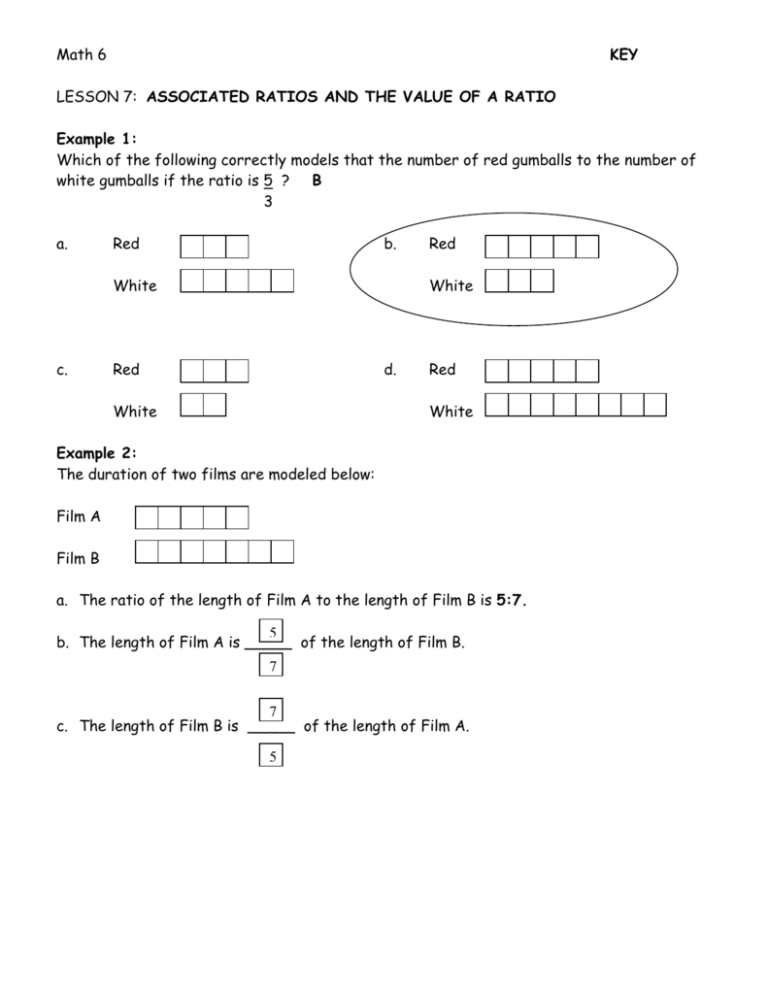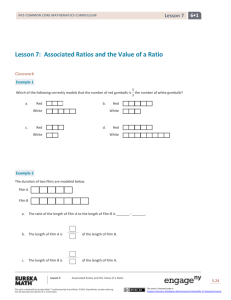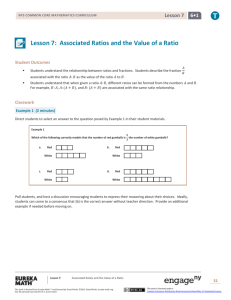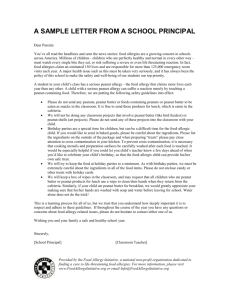Lesson 7
advertisement

Math 6 KEY LESSON 7: ASSOCIATED RATIOS AND THE VALUE OF A RATIO Example 1: Which of the following correctly models that the number of red gumballs to the number of white gumballs if the ratio is 5 ? B 3 a. Red b. White c. Red White Red d. White Red White Example 2: The duration of two films are modeled below: Film A Film B a. The ratio of the length of Film A to the length of Film B is 5:7. 5 b. The length of Film A is _____ of the length of Film B. 7 7 c. The length of Film B is _____ of the length of Film A. 5 GROUP WORK: Exercise 1: Sammy and Kaden went fishing using live shrimp as bait. Sammy brought 8 more shrimp than Kaden brought. When they combined their shrimp they had 32 shrimp altogether. a. How many shrimp did each boy bring? 32 shrimp minus 8 = 24; 24 divided by 2 (# of boys) = 12; so Kaden brought 12 shrimp and Sammy brought 20 shrimp (12 + 8) Kaden Sammy 12 4 4 4 4 4 +20 32 total 8 more than b. What is the ratio of the number of shrimp Sammy brought to the number of shrimp Kaden brought? Sammy to Kaden = 20 to 12 c. Express the number of shrimp Sammy brought as a fraction of the number of shrimp Kaden brought. Sammy = 20 Kaden 12 d. What is the ration of the number of shrimp Sammy brought to the total number of shrimp? Sammy : Total number of shrimp 20:32 e. What fraction of the total shrimp did Sammy bring? 20 32 Exercise 2: A food company that produces peanut butter decided to try out a new version of its peanut butter than is extra crunchy, using twice the number of peanut chunks as normal. The company hosts a sampling of its new product at grocery stores and finds that 5 out of every 9 customers prefer the new extra crunchy version. A. Let’s make a list of ratios that might be relevant for this situation: a. The ratio of number preferring new extra crunchy to the total number surveyed is 5:9 b. The ratio of number preferring regular crunchy to the total number surveyed is 9:9 c. The ratio of number preferring regular crunchy to the number preferring new extra crunchy is 9:5 d. The ratio of number preferring new extra crunchy to the number preferring regular crunchy is 5:9 B. Let’s use the value of each ratio to make multiplicative comparisons for each of the ratios we described here: 5 a. The number preferring new extra crunchy is of the total number surveyed. 9 9 b. The number preferring regular crunchy is of the total number surveyed. 9 9 c. The number preferring regular crunchy is of those preferring new extra crunchy. 5 5 d. The number preferring new extra crunchy is of those preferring regular crunchy. 9 C. If the company normally sells a total of 90,000 containers of regular crunchy peanut butter, how many containers of new extra crunchy peanut butter should it produce, and how many containers of regular crunchy peanut butter should it produce? What would be helpful in solving this problem? Does one of our comparison statements above help us? 10,000 containers x 9 Regular crunchy = 90,000 containers New extra crunchy 10,000 containers x 5 = 50,000 containers of new extra crunchy should be produced. Try these next scenarios: D. If the company decides to produce 2,000 containers of regular crunchy peanut butter, how many containers of new extra crunchy peanut butter would it produce? E. If the company decides to produce 10,000 containers of new extra crunchy peanut butter, how many containers of regular crunchy peanut butter would it produce? F. If the company decides to only produce 3,000 containers of new extra crunchy peanut butter, how many containers of regular crunchy peanut butter would it produce? LESSON SUMMARY: For a ratio A:B, we are often interested in the associated ratio B:A. Further, if A and B can both be measured in the same unit, we are often interested in the associated ratios A: (A+B) and B: (A+B). For example, if Tom caught 3 fish and Klye caught 5 fish, we can say: The ratio of the number of fish Tom caught to the number of fish Kyle caught is 3:5. The ratio of the number of fish Klye caught to the number of fish Tom caught is 5:3. The ratio of the number of fish Tom caught to the total number of fish the two boys caught is 3:8. The ratio of the number of fish Klye caught to the total number of fish the two boys caught is 5:8. For the ratio A:B, where B ≠ 0, the value of the ratio is the quotient A B. For example: For the ratio 6:8, the value of the ratio is 6 or 3 . 8 4









